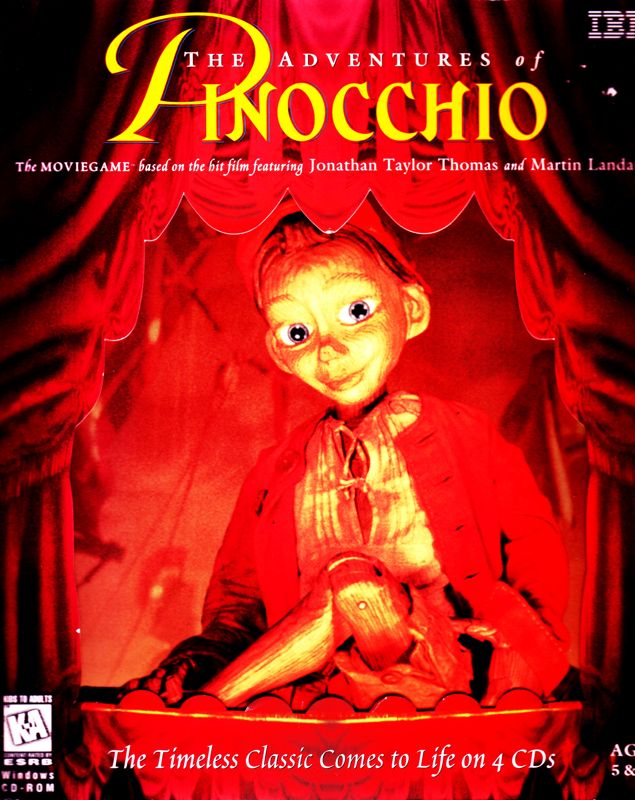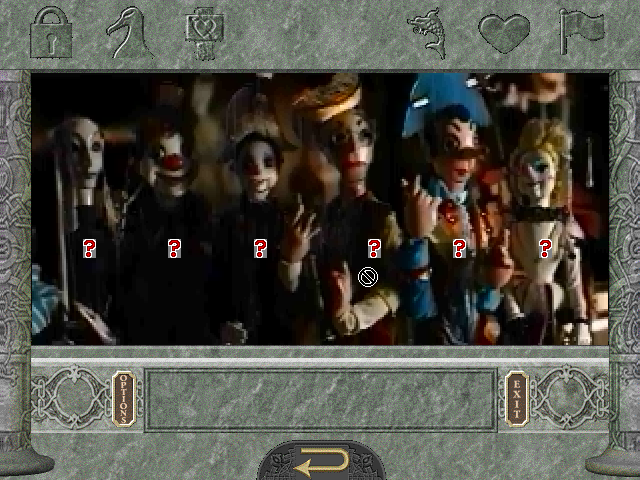Retro Replay Review
Gameplay
The Adventures of Pinocchio puts you in the director’s chair of an interactive movie adventure, blending full‐motion video (FMV) sequences with point‐and‐click exploration. You navigate through four distinct realms—The Village, The Forest, The Sea, and Terra Magica—by clicking on hotspots around the video window or directly on the action itself. This hybrid interface invites you to solve puzzles, dodge traps, and steer Pinocchio’s journey with a mix of instinct and strategy.
Unique transformations lie at the heart of the game’s challenge. At various moments, you must turn Pinocchio into a puppet, a fish, a bird, or even a donkey to bypass obstacles or reach otherwise inaccessible areas. Each form carries its own movement quirks: water currents test your fish reflexes, while narrow passages demand nimble puppet maneuvering. These shifts keep the gameplay fresh and force you to adapt your puzzle‐solving approach on the fly.
Adding another layer of interactivity is the voice recognition feature. By speaking into a compatible microphone, you can answer prompts or trigger actions without lifting a finger. Although theatrical and innovative for its time, this system can be finicky, occasionally mishearing commands or requiring repeated attempts. Even so, it underscores the game’s ambition to merge cinematic immersion with active participation.
Graphics
The Adventures of Pinocchio leans heavily on FMV, showcasing wide‐screen scenes lifted straight from the 1996 live‐action movie alongside original footage shot exclusively for the game. Video clips occupy about half of your screen, framed by static, illustrated backdrops that fill out the visual field. This split‐screen presentation creates the sensation of peering through a theater window into Pinocchio’s world.
While the FMV sequences capture genuine actors, set pieces, and period‐style costumes, the video resolution reflects mid‐’90s CD‐based technology. Graininess, muted color saturation, and occasional video compression artifacts are par for the course, especially during fast‐paced transformations or underwater scenes. Still, the cinematic shots convey an authentic fairy‐tale atmosphere that many modern titles can’t replicate.
The game’s original art assets help bridge FMV transitions, with hand‐painted backdrops that represent the monster‐infested waters, the dense woods, and the whimsical stalls of Terra Magica. Puppet, fish, bird, and donkey forms receive distinct sprite treatments, though animation frames are limited. For those willing to embrace its vintage aesthetic, the graphics exude nostalgic charm and a clear sense of theatrical staging.
Story
Based closely on the 1996 film, The Adventures of Pinocchio picks up just after our wooden hero achieves his lifelong dream of becoming a real boy—only to be snatched by the nefarious Lorenzini and magically reverted to puppet form. Your role is not just to rescue Pinocchio but to guide his maker, Geppetto, through a series of moral trials that test courage, loyalty, and compassion.
Along the way, you collect six symbolic passwords, each representing a vital lesson in honesty, bravery, and selflessness. These tokens aren’t mere collectibles; they unlock new narrative branches and puzzle solutions, forging a tangible link between Pinocchio’s character growth and your own choices. The structure encourages multiple playthroughs if you want to see all the moral outcomes and FMV endings.
Two live‐action guides—Lumina and Candlewick—pop up at critical junctures to offer advice, reflect on Pinocchio’s progress, and sometimes debate the best course of action. Their presence adds a dynamic layer to the narrative, as you must weigh their conflicting viewpoints before making decisions. This interplay of moral commentary and direct involvement keeps the story engaging and suitably child‐friendly without feeling overly simplistic.
Overall Experience
The Adventures of Pinocchio is a nostalgic trip into the heart of 1990s interactive cinema. Its combination of live‐action footage, voice control, and transformation mechanics sets it apart from typical adventure games of the era. Fans of the movie will appreciate revisiting the sets and actors, while puzzle lovers will find enough variety in shape‐shifting challenges and hotspot hunts to stay engaged.
On the flip side, the game’s reliance on CD‐based FMV limits visual clarity and loading times, and the voice recognition—while ambitious—can test your patience if it misinterprets commands. The click‐driven puzzle interface sometimes feels cumbersome, with small hotspots and occasional trial‐and‐error segments that interrupt the narrative flow.
Ultimately, this title shines brightest for those who value interactive storytelling and retro gaming quirks over cutting‐edge graphics or lightning‐fast controls. It’s an ideal pick for families, nostalgic gamers, and younger players learning basic puzzle logic. If you’re intrigued by moral lessons wrapped in a cinematic fairy tale and don’t mind a bit of dated tech, The Adventures of Pinocchio offers a unique and heartfelt journey.
 Retro Replay Retro Replay gaming reviews, news, emulation, geek stuff and more!
Retro Replay Retro Replay gaming reviews, news, emulation, geek stuff and more!









Reviews
There are no reviews yet.